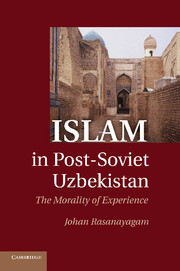Islam hardly featured in my first research project in Uzbekistan between 1998 and 2000 in the city of Andijan in the Fergana Valley and the nearby village of Pakhtabad. At that time, I was not looking specifically at Islam but was interested in the state as it is experienced on a daily basis. I focused my attention on the activities of small-scale entrepreneurs, practices of corruption, household income–generating strategies, and networks of exchange as sites in which the state becomes locally manifested. Even so, looking back on that research, I am surprised by how little attention I devoted to Islam in developing my understanding of the individual, the household, the community, and the state in Uzbekistan.
I was aware while conducting that research that almost all of the people I was working with considered themselves Muslim except, of course, the Russian, Korean, or other non–Central Asian minority populations who mainly resided in the city of Andijan. Life-cycle events for the Central Asian population, such as marriages and funerals, invariably incorporated Islamic rituals, and particularly in the village of Pakhtabad, many of the other occasions of feasting that link households within wider kinship and neighbourhood relations take place within an Islamic frame, such as iftor meals to break the fast during the month of Ramadan. In addition, Islamic references are present in much of day-to-day interactions.
